https://phys.org/news/2020-10-feature-energy-spectrum-universe-powerful.html
University of Delaware researchers are part of collaboration studying cosmic rays. In addition to Cherenkov detector tanks filled with water, the Pierre Auger Observatory in Argentina has a second kind of cosmic-ray catcher — fluorescence detectors. The charged particles in a cosmic-ray air shower interact with atmospheric nitrogen, causing it to emit ultraviolet light through a process called fluorescence, which is invisible to the human eye — but not to this optical detector.
Credit: University of Delaware
Particles smaller than an atom hurtle through the universe nearly at the speed of light, blasted into space from something, somewhere, in the cosmos.
A scientific collaboration of the Pierre Auger Observatory, including researchers from the University of Delaware, has measured the most powerful of these particles—ultra-high-energy cosmic rays—with unprecedented precision. In doing so, they have found a "kink" in the energy spectrum that is shining more light on the possible origins of these subatomic space travelers.
The team's findings are based on the analysis of 215,030 cosmic ray events with energies above 2.5 quintillion electron volts (eV), recorded over the past decade by the Pierre Auger Observatory in Argentina. It is the largest observatory in the world for studying cosmic rays.
The new spectral feature, a kink in the cosmic-ray energy spectrum at about 13 quintillion electron volts, represents more than points plotted on a graph. It brings humanity a step closer to solving the mysteries of the most energetic particles in nature, according to Frank Schroeder, assistant professor at the Bartol Research Institute in UD's Department of Physics and Astronomy, who was involved in the study with the support of the University of Delaware Research Foundation. The research is published in Physical Review Letters and Physics Review D.
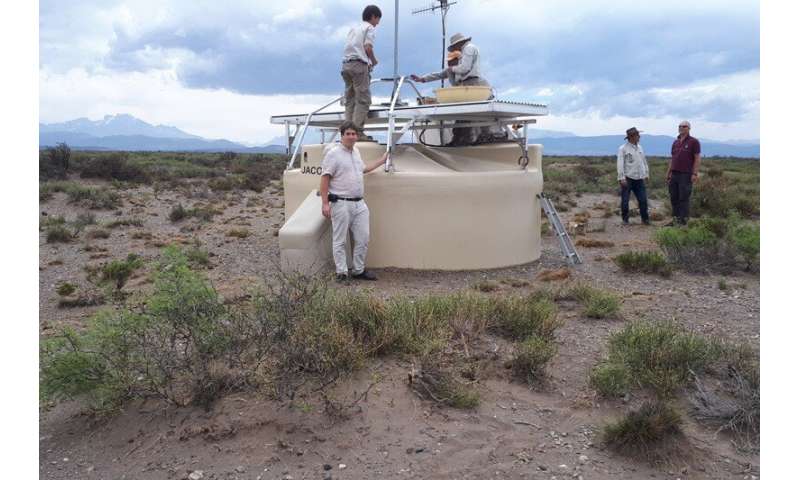
In this pre-pandemic photo, UD Professor Frank Schroeder works with colleagues to install a radio antenna on one of the cosmic ray detector stations of the Pierre Auger Observatory, located near Malargüe, Argentina.
Credit: University of Delaware
"Since cosmic rays were discovered 100 years ago, the longstanding question has been, what accelerates these particles?" Schroeder said. "The Pierre Auger Collaboration's measurements provide important hints about what we can exclude as the source. From previous work, we know the accelerator is not in our galaxy. Through this latest analysis, we can further corroborate our earlier indications that ultra-high-energy cosmic rays are not just protons of hydrogen, but also a mix of nuclei from heavier elements, and this composition changes with energy."
Between the "ankle" and the "toe"
Schroeder and UD postdoctoral researcher Alan Coleman, who contributed to the data analysis, have been members of the Pierre Auger Collaboration for several years. UD officially joined the collaboration as an institutional member in 2018. This team of more than 400 scientists from 17 countries operates the observatory, which occupies a 1,200-square-mile area, about the size of Rhode Island.
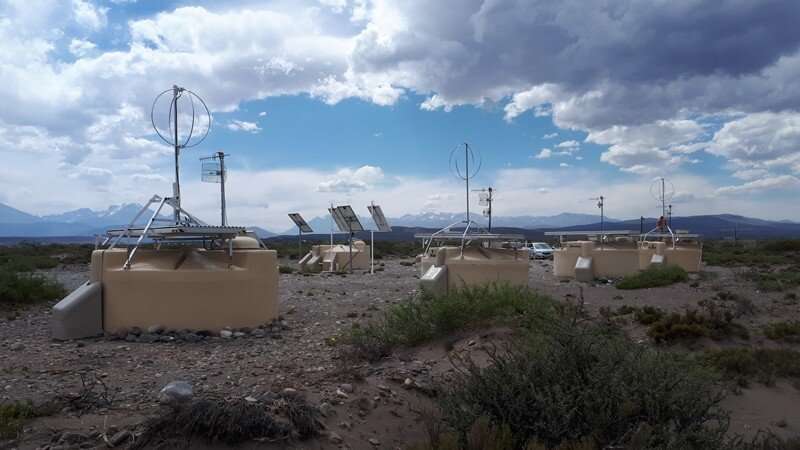
An array of cosmic ray detector stations of the Pierre Auger Observatory near Malargüe, Argentina. The University of Delaware is a member of the international collaboration that operates the observatory, which includes more than 400 scientists from 17 countries.
Credit: University of Delaware
Previously, scientists thought these ultra-high-energy cosmic ray particles were mostly protons of hydrogen, but this latest analysis confirms that the particles have a mix of nuclei—some heavier than oxygen or helium, such as silicon and iron, for example.
Plotted on the curving graph representing the cosmic-ray energy spectrum, you can see the kink—a steep, flattened section—between the area referred to by scientists as "the ankle," and the beginning point of the graph, called "the toe."
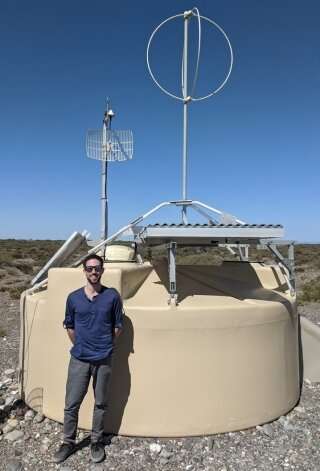
In this pre-pandemic photo, UD postdoctoral researcher Alan Coleman stands by one of the Pierre Auger Observatory’s 1,600 cosmic ray detector stations, which are spread out across 1,200 square miles of the Pampa Amarilla. The corrugated metal on top, called a scintillator panel, and the spherical radio antenna are both sensors for cosmic rays, while the rectangular antenna is for communication with the observatory’s central building.
Credit: University of Delaware
"We don't have a specific name for it," said Coleman, who was on the 20-person team that wrote the computer code and did the number crunching required for the extensive data analysis. "I guess we are running out of parts of the anatomy to call it," he said, joking.
Directly involved in the finding, Coleman improved reconstruction of the particle cascade, which cosmic-rays create when impinging the atmosphere, in order to estimate the energy. He also performed detailed studies to ensure that this new inflection point was real and not an artifact of the detector. The data group's work took more than two years.
"Obviously, it's pretty slight," Coleman said of the spectral kink. "But every time you see a bump like this, that signals the physics is changing and that's very exciting."
It's very hard to determine the mass of incoming cosmic rays, Coleman said. But the collaboration's measurement is so robust and precise that a number of other theoretical models for where ultra-high-energy cosmic rays are coming from can now be eliminated, while other pathways can be pursued with more vigor.
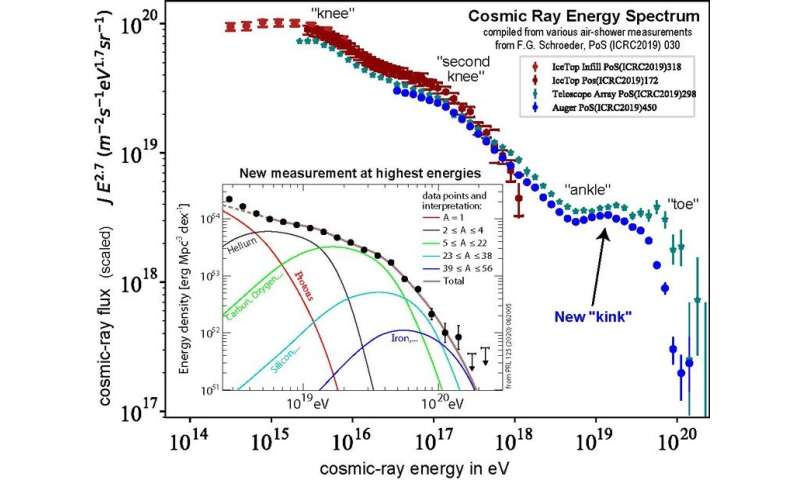
The flux of cosmic rays is dependent on their energy. The higher the energy, the rarer the cosmic rays. However, the larger figure shows this relationship is not smooth. Several features indicate something is happening at different energies, referred to informally by scientists as the “knee,” the “ankle” and the “toe,” along with the “new kink,” measured by the Pierre Auger Observatory Collaboration. The inset shows this new measurement in detail. Each feature can be interpreted as a change in the composition of cosmic rays at the respective energies. Credit: University of Delaware
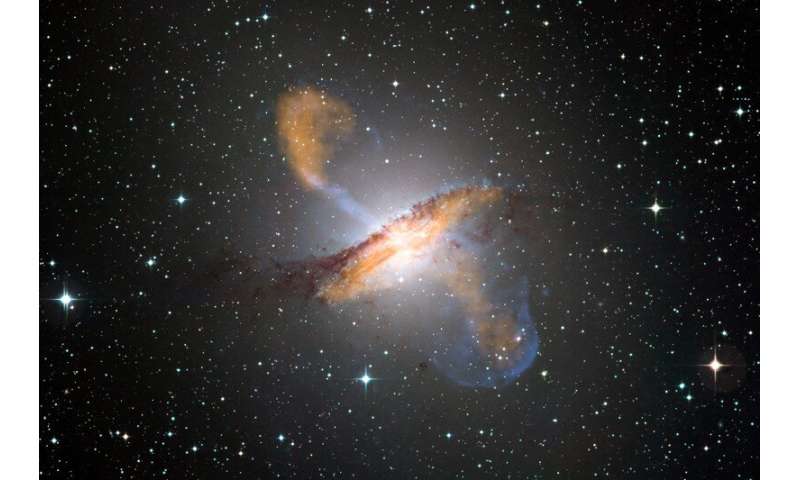
Scientists speculate that active galactic nuclei may be a source of ultra-high-energy cosmic rays. Active galactic nuclei are supermassive black holes in the center of galaxies, which feature gigantic jets of matter that escape falling into the black hole. Centaurus A, shown here, is an example of this galaxy class in our galactic neighborhood less than 20 million light-years from Earth. Credit: University of Delaware
Active galactic nuclei (AGN) and starburst galaxies are now in the running as potential sources. While their typical distance is some 100 million light years away, a few candidates are within 20 million light years.
"If we learned what the sources were, we could look into new details about what is going on," Coleman said. What's happening that allows these incredibly high energies? These particles may be coming from something we don't even know."
Ongoing research by the UD team focuses on further increasing the measurement accuracy of ultra-high-energy cosmic rays and extending the precise measurement of the cosmic ray spectrum down to lower energies. That would create a better overlap with other experiments, Schroeder said, such as the cosmic ray measurements of IceCube at the South Pole—another unique astroparticle observatory with major involvement of the University of Delaware.
Recommend this post and follow Sputnik's Orbit
https://disqus.com/home/forum/thesputniksorbit-blogspot-com/



No comments:
Post a Comment